The Feast of St. Anne
This week: 40ºC and climbing; The Feast of St. Anne; Vegetarianism; Anyone for Cricket?; Time to get the juicer out; Looking back;

We’re having a heat wave here in the Balkans and across most of the eastern Mediterranean.
The temperature exceeded 40ºC in Stari Grad several times this week, while it was cool 37.3 ºC here in Dol.
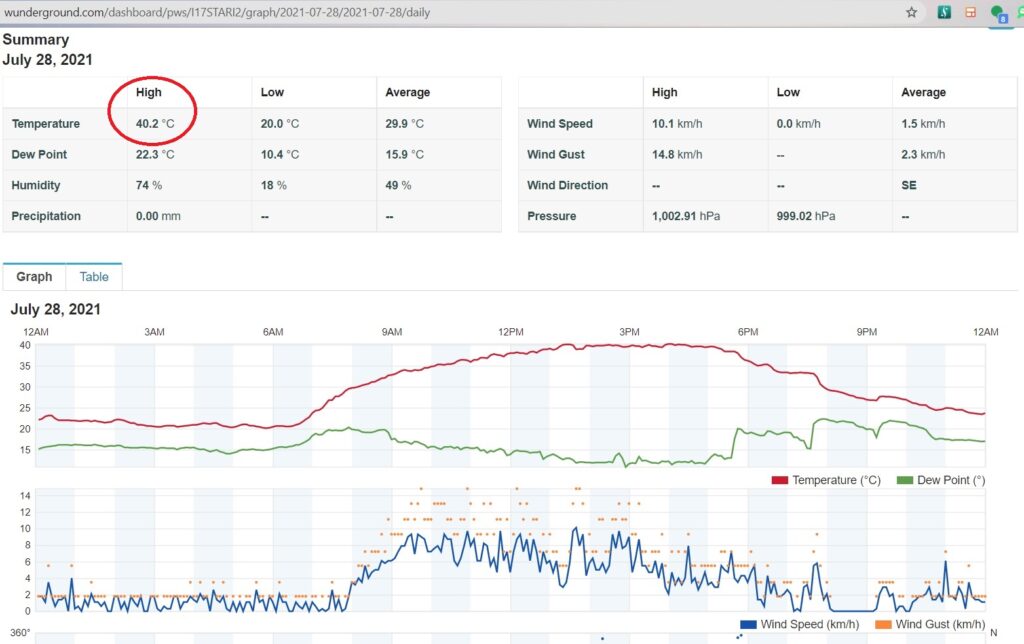
Another heat dome has developed over this part of the world. There is a very good description of a heat dome and also the current situation on the Severe Weather Europe website.
From my limited weather records, I’ve identified that the next couple of weeks are always the hottest of the year. However this summer has been different, with severe heat much earlier than usual.
Another “just by chance” discovery this week has been the result of a change in my irrigating schedule.
Being busy on Monday evening, I watered early on Monday morning instead.
On Tuesday morning when I was going round to ‘top up’ the plants and trees moisture levels, I found that everything was looking much better having just had water on Monday morning.
They looked significantly more healthy than they have done when watered only at night.
I have a vague recollection, which I now cannot substantiate, that watering in the evening allowed plants to draw as much moisture as they needed from the soil overnight.
This was supposed to be better, but now I am not so sure.
Usually by evening, with our current day time temperatures of over 35ºC, some plants are visibly wilting by the time of the next irrigation cycle.
Only the hardiest look even remotely healthy at the moment.
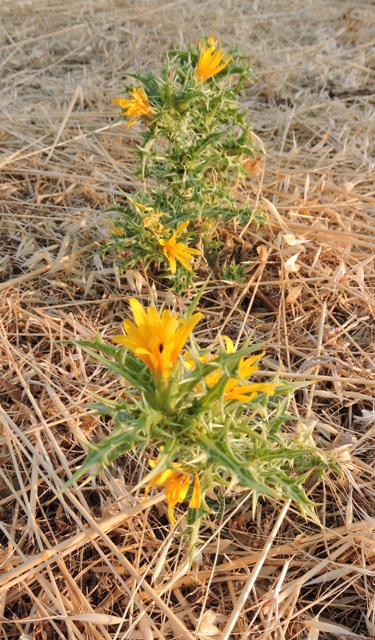
Morning irrigation does not have the same effect. Plants are not wilting by the following morning.
The problem is that being 200 litres per metre² down on even our usual meagre summer precipitation has left my thin soils completely bereft of any moisture.
Quite simply, we need some sustained rainfall. This is not going to happen until September at the earliest.
I now know what the tree is that my neighbour cut down, which I photographed last week.
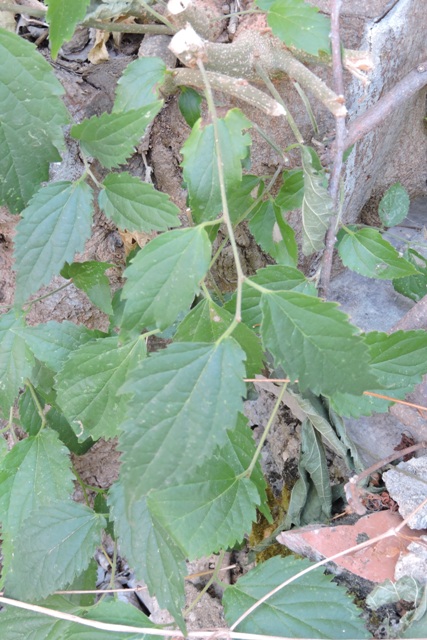
It is a European Nettle Tree, confusingly named in Latin as Celtis australis.
Another neighbour, Steve, tells me he has seen the Nettle Tree Butterfly, on his tree.
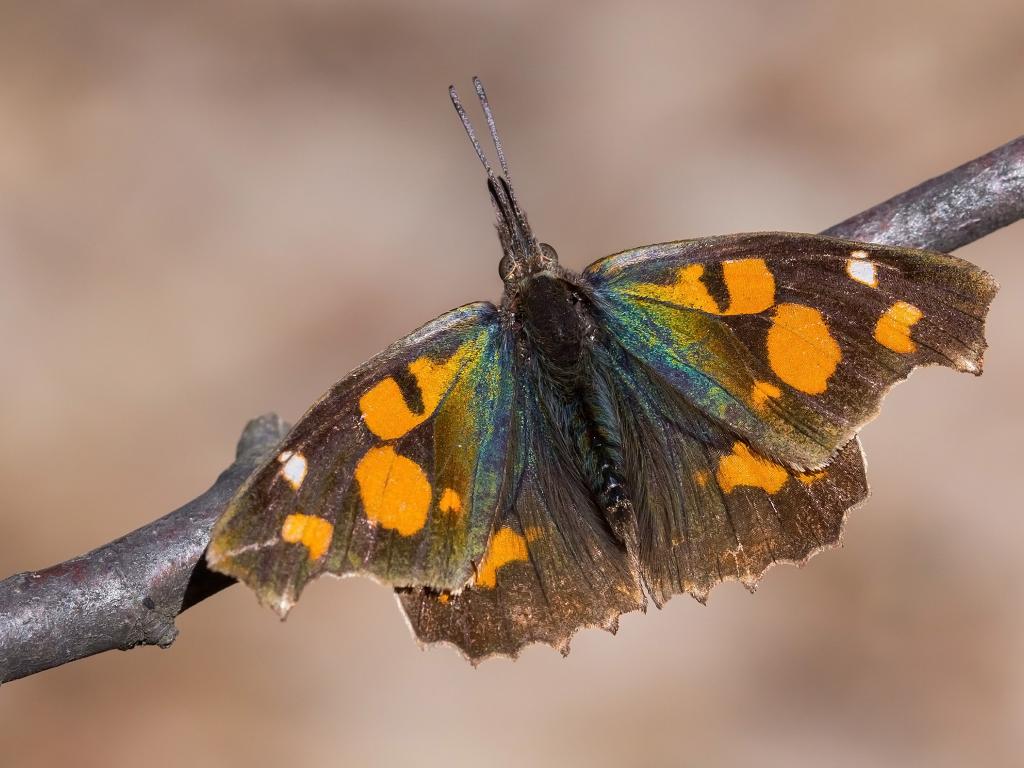
The tree has small black edible fruits, which are mostly stone and presumably these are spread liberally around by the birds. Hence the myriad saplings that appear each spring.
This is not a butterfly I have seen, although our gardens are less than 50 meters apart as the butterfly flies. I will have to look out for them.
The trees are native to the Mediterranean, grow quickly and can reach a height of 25 meters. They can withstand drought conditions because of their deep root system and readily self seed.
They are definitely a “weed tree”!
40ºC and climbing
There have been a slew of academic papers released this week on the effects that climate change is having around the globe.
The sources vary from the UK Met office “The state of the UK Climate”, through the Royal Meteorological Society to several papers in Nature Climate Change journal.
Although some are UK organisations, the reports and the findings apply equally across all countries.
Reports from the World Weather Attribution Initiative are indicating that the earth is already at the point that the climate models suggested we would be at by the second half of this century.
In all, it does not bode well for the future of life on earth.
There has been much discussion in the media about what can be done to make homes comfortable in extreme heat. The universal answer is NOT air conditioning.
In just the same way, sudden torrential downpours and flooding need mittigation measures at both individual and societal levels, just as excessive heat does.
At the moment, rain is what we lack the most here in Dol.
I’ve been reading up on heat exchangers, however there is a problem with the technology in the Mediterranean.
Several times this week, the house has been at or above 30ºC overnight. Drafting part of the blog at 20:00 on Thursday, the inside air temperature was 32.8º C while the outside air temperature is 30.3º C.
Now on Saturday afternoon, it is 36.8 ºC outside and 33.2 ºC inside.
For a heat exchanger to work efficiently, there needs to be a significant temperature differential of 15 or more degrees, between the hot air and the cool air.
A 2.5 degree difference or thereabouts is simply not enough to make the device work.
It is considerably cooler downstairs in the Konoba, perhaps 18º C or 20º C. I’m not sure because I haven’t measured it. However it feels pleasantly cool when you walk in, although that isn’t difficult when it is well over 30º C in the courtyard outside.
So better insulation on the outside south and west facing walls of the building is going to be needed. My ceilings and floors already have 10 cm of Styrofoam insulation installed.
I found several interesting research papers on Passive Thermal Cooling, especially about how to adapt old buildings.
Some of what they suggest I am already doing, for example using differential pressure in opposite sides of a building with windows and doors being left open.
This creates a through draught. There is also some interesting material on using water inside and a modern iteration of the Arabic Wind Towers. I shall have to do some more research on my own I think.
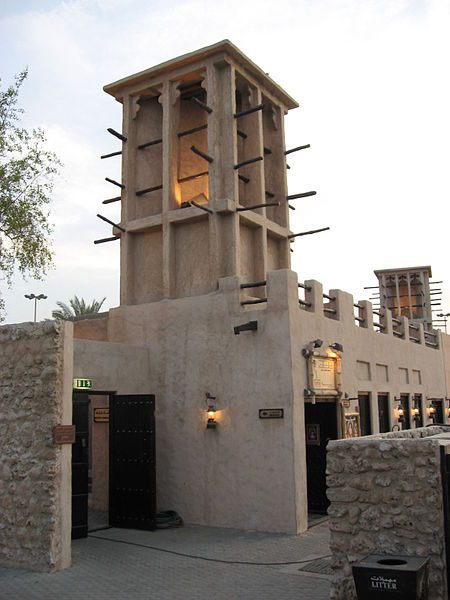
What is absolutely clear is that what the world is experiencing at the moment is the new normal, and both individually and collectively we had better have some plans to deal with it!
The Feast of St. Anne
My near neighbours invited me to dinner on Monday evening, but with certain government rules being in place.
Everyone had to have their EU COVID Vaccination certificate, proving two doses of the vaccine had been administered, and masks when not eating.
There would be just eight people present, although one or two more may “drop in” as is the custom in these parts.
The government has mandated that all gatherings, even private ones, with fifteen or more people must be COVID safe, with only fully vaccinated, recently negative tested, proven antibodies or a medical vaccine exemption being allowed.
This virus is still being taken seriously here… Monday was the 26th July, the Feast of St. Anne.
The village of Dol is in two parts, with three churches. The magnificent St. Michael’s on the promontory dividing the village into two.
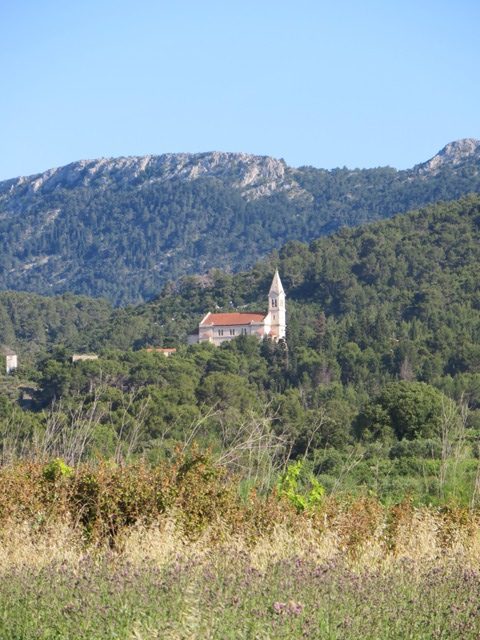
On the west side lies Dol Svet Marija and on the east side, where I live, is Dol Svet Anna – St. Anne’s Dol.
Across the whole of Mediterranean Europe, towns and villages all have “their” Saint’s day. The day in the year when there are parties, festivities, parades, sometimes fireworks, and of course celebrations.
Our Church of St. Anne is an ancient structure, located in the valley bottom, opposite the building which was once the school and village hall. It sits at a cross-roads, so anyone coming into this village along the main road would have to pass the Church.
Our village celebration tends to be more low key, with an evening dinner for neighbours, friends and relatives being the normal event.
The day falls in the middle of the summer season, when most people are busy – in normal years at least – with the influx of visitors. So there are no grand parades, or big events marking seasonal changes.
The village festival, call Puhijada should begin next week, but because of the Covid restrictions requiring everyone to be vaccinated and to show their passport, it has been cancelled for a second year.

All the little Puhs will be happy though. There will be no one trapping them to turn them into a roast supper.
The Balota inter village competition will still take place, but without crowds.
Vegetarianism
I have become fully vegetarian this year.
My tipping point was reached at the end of winter when I was invited out for dinner and was offered some roast lamb and it just didn’t taste right or nice.
There was nothing wrong with it, it was just me.
I have seldom eaten meat for years. Just occasionally buying chicken or mince.
More than 20 years ago I remember saying that if I was told by the doctor that I could never eat another piece of meet, I would not feel upset in the slightest.
I last bought chicken in September I think. Ever since I have just been eating fruit and vegetables, with as much as possible sourced from my land.
There is no “farmers market” as such on the island, but in both Grad Hvar and Stari Grad, there are small market stalls where the proprietors sell local produce, as well as wholesaler supplied fruit and vegetables.
This is another reason why I try and always preserve some of my seasonal fruits, so in the lean winter months I still have fresh fruits on the table.
With a year and a half of lockdowns, I have only needed to tell just one or two people.
Monday was the first time I have been to dinner with the neighbours since I went completely green, so I told them in advance. Their response was “not a problem”.
I did wonder how the announcement would be received in a place where meat is a staple of almost every meal, in some way, shape or form.
It was actually well received. One of the other guests said how much they respected me for making the decision and they are also probably 90% vegetarian now and heading the same way as me.
I said I would make one of my usual desserts, but I also decided to make a cheese and tomato Quiche as a cold starter. Always an easy dish to prepare and completely vegetarian too.
The weather is still very warm, so a chilled starter always seems like a good idea. The quiche was sourced mainly from local produce: eggs from my neighbours very free range hens; tomatoes from the orchard; a couple of onions and some chives from the kitchen garden.
When I bake, I tend to make two of eveything. My oven is large, so I did two version of quiche, then cut and presented then on the same platter.

For dessert, I again used garden products.
Galettes are very easy and quick to make, so I made two small versions. The first with apricots and fresh passionfruit, picked just before cooking.
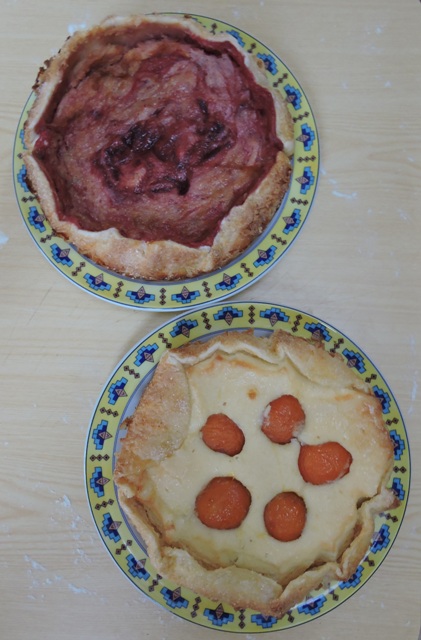
The second with de-stoned red plums, all in a fresh cheesecake filling.
Which reminds me…
Which Italian cheese do you use to hide a small horse?
Answer: Mascaponé
“I’ll go an get me ‘at”…
Anyone for Cricket?
Breakfast time in Dol can be interesting.
Apart from my felines, the neighbours felines also often appear for something to eat too.
They always have a forlorn look, “Keine Mama, kein Papa, kein Frühstück…” – They speak very good German…
Then there are the insects which attach themselves to the wire screen across the doorway.
On Thursday morning a green flash caught my eye on the screen.
The shape said “grasshopper” but it was way too bright for the big grey Egyptian grasshoppers that we have here.

As I looked closer I could see it had antenae longer than it’s body length, and a brown ovipostor. So it was a Cricket.
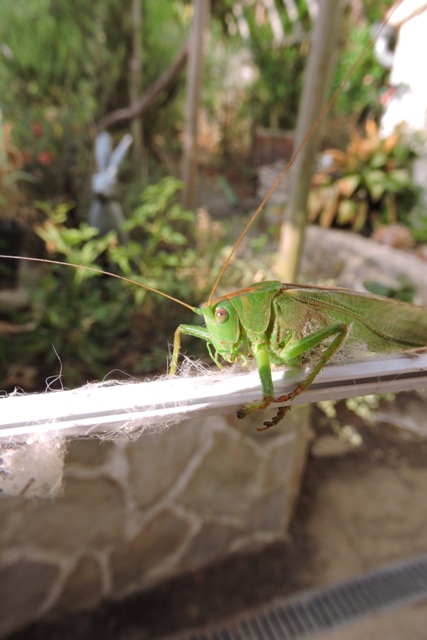
Crickets come in two sizes. There are the small noisy and dark coloured variety, whose constant stridulating at night in the house keeps you awake.
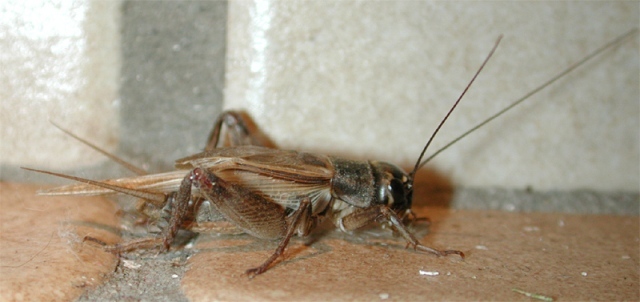
Then there are the large, three to five centimetre long, multi coloured varieties. But this vibrant green version I have not seen before.
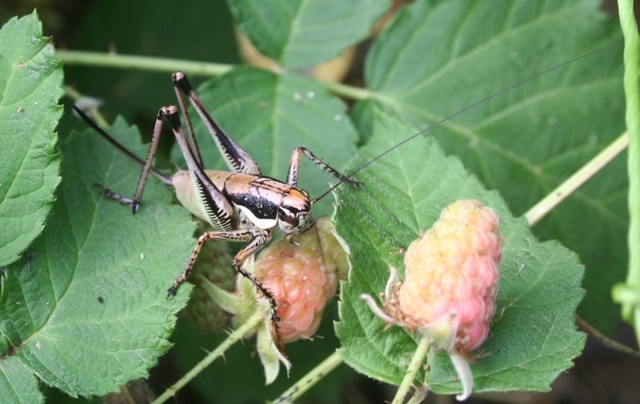
It was a female and she had lost one of her large hind jumping legs, so not wanting to frighten her I persuaded her to climb on a stick to be photographed, before I returned her to a more natural habitat.
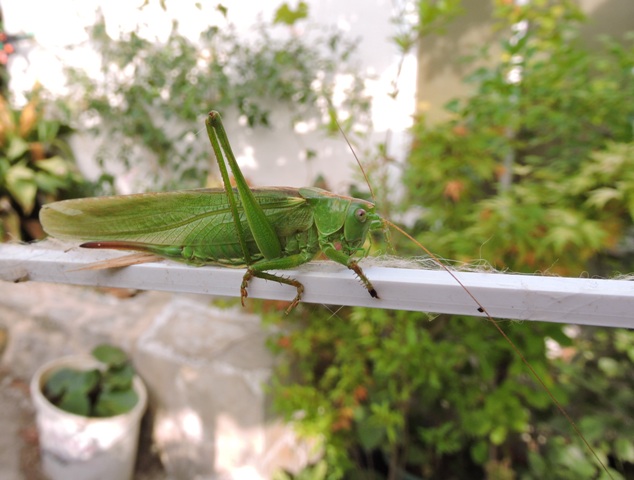
The larger field Crickets have superficial similarity to grasshoppers. Crickets are part of the order Tettigoniidae and are called Katydids, after their three pulse song which to human ears sounds like ‘Ka – ty – did’.
I turned to my go-to book, the Collins Complete Guide to Mediterranean Wildlife (ISBN: 978-0-00-220161-2), which listed two possible species.
The Great Green Bush Cricket, Tettigonia viridissimo, or the Long Winged Conehead, Conocephalus fuscus.
Enlarging the photos, I am sure it is a female Great Green Bush Cricket because of the colours and the long, brown ovipostor. The head shape is wrong for the Conehead.
This Katydid is omnivorous and especially likes aphids, but lays her eggs in grass. So she is another friends of gardeners.
Grass is a bit thin on the ground at the moment, so I went to see if she was still amongst the green leaves of the saplings in the nursery where I left her. I was thinking to move her to a better spot.
She had gone, either completely camouflaged and invisible, or flown off to pastures new.
Time to get the juicer out
Watching nature is a good way to tell you what you should be doing.
In the old days, the passage of the seasons was marked not by dates and months, but by the tasks which took place at the particular time of year.
People know what should be done based on the phase of the moon and what they saw around them.
With Latin based languages, the months of the year are all very similar, whatever language it is.
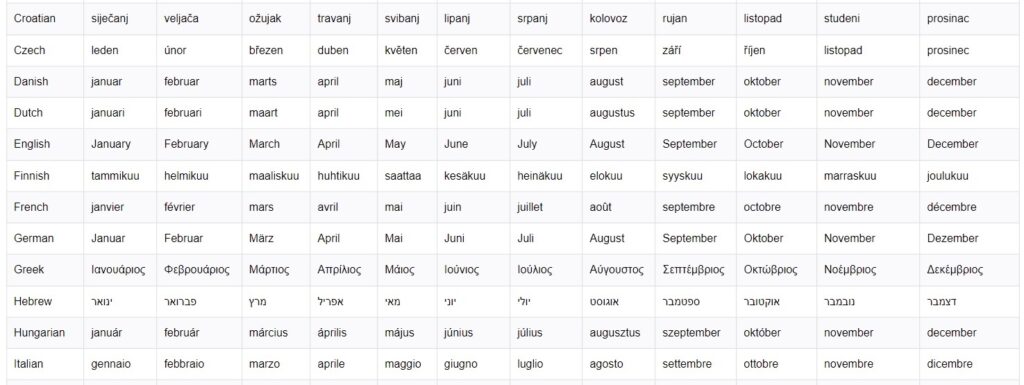
Croatian being derived from Slavic languages, uses the much older names which were based on agricultural tasks, weather and natural happenings for that month.
Climate change has upended these old patterns, but the month’s names in Croatian still exist. August is called Kolovoz, from the root Kolo voziti – driving the waggon to harvest.
In the Roman calendar, August was the sixth month in the year, called Sextillia. Then when months were given names, the Emperor Augustus changed the name, calling it after himself of course.
Most months still followed the old roman pattern like December, the tenth month Decimus in Latin. January was named after the Roman God Janus, God of beginnings and endings. He is often depicted as having two faces.

On the island although the official name is Kolovoz, the month is also known as ‘osam’ or ‘osmi’, 8 or 8th. This shows the island’s links to Italy, Latin and how culture is still intertwined in the local dialect.
I have watched my Blackbird family this week feeding on my grapes. With Mum, Dad and three fledglings taking it in turn to pull ripe fruit off the vine, testing for ripness in their beaks and throwing unripe fruit away.
Either that or they were throwing the fruit, like little musket balls, at which ever feline was watching them from ground level, mouthing veiled threats towards them.

This is a very old vine whose thick stem winds it’s way around my patio roof and guttering, providing shade throughout the summer and some small fruit as well.
The grapes are not the largest, but then I don’t prune the vine for fruit, rather for shade. However it is still possible to gather sufficient bunches of grapes to make juicing them worthwhile.
I think I will have to get the juicer out next week. NCG
Looking back – Week 20
This is the start of a new weekly section, with links to past issues of the blog.
2014/30 Ho, ho, hoe

2015/30 Help when you want it, just ask

2016/30 Bedbugs and broomsticks
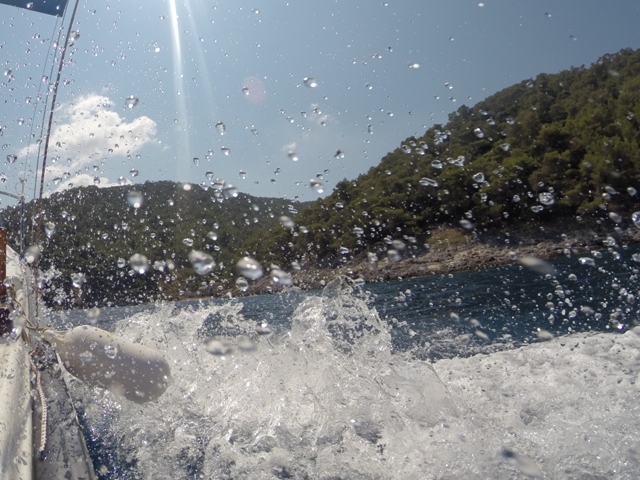
2017/30 A snake in the leaves

2018/30 Far off the Beaten Track

2020/30 Honesty is finished
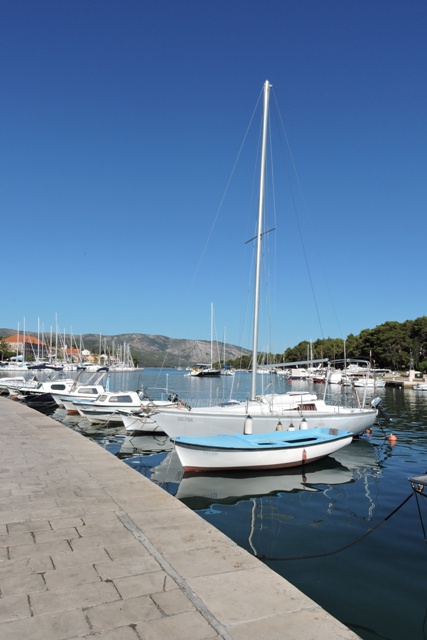
2 Responses
John Bailey
I agree with you Norman on climate change. The seasons seem to be all mixed up. Winters are very mild. Vegetables like runner beans which cannot tolerate frost can still be picked in November. As you say it doesn’t bode well for future generations.
Tony Griggs
Hi Norman. It’s taken millions of years for the human population to reach 1 billion (around 1804). In 2021, just over 200 years later, it’s increased 7+ fold. That’s my answer to global climate change!
https://www.independent.co.uk/climate-change/news/humans-are-a-plague-on-earth-sir-david-attenborough-warns-that-negative-effects-of-population-growth-will-come-home-to-roost-8461570.html